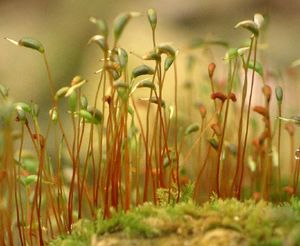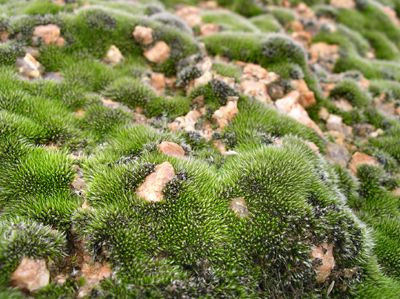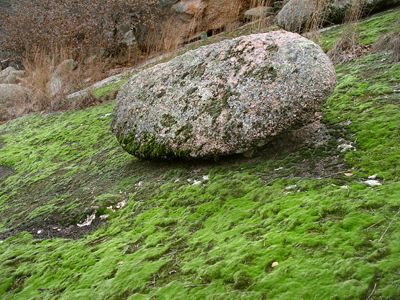
moss with sporophytes
 moss with sporophytes |
It is true that an itinerant stone rarely supports any botanical hitchhikers, but those mineral chunks that are left in peace may develop quite a luxuriant garden. Perhaps the real meaning of that little cliché is to point out how it is BETTER to stay in one place and put down roots than to live an unsettled and nomadic existence. Many rocks are rather plain in appearance, but those adorned with garlands of lacy green vegetation are certainly more attractive, if not downright gorgeous.
 moss on granite |
There is one hindrance to first noticing and then studying the intricate details of mosses. We, as human-sized entities, may find it hard to appreciate a paradise that is too small for us to enter. Like Alice confronted with a tiny door she cannot possibly fit through without dream-induced magic, we are barred from the minute world that we can only observe at a distance. But we certainly can look. And appreciate.
Instead of the trees, flowering herbs, shrubs, and grasses with which we are so familiar, the layer of vegetation that grows no more than an inch or so high has grasses towering over minute forbs, gametophytes, spore cases, and sporophytes. Since even the labels applied to parts of mosses are alien sounding, like the biological terms for the bones and muscles of an animal, most people would probably just prefer to skip them and move on to appreciating mosses for the lovely little plants they are. Sounds good to me.
Because mosses are almost invariably down on the ground, special effort must be made to get close enough to really SEE them. This is perhaps easiest for children, as they are naturally closer to the ground, usually have pretty good eyesight, and feel no chagrin about crawling around to look at something that is almost invisible from 5 feet up. Children and adults alike, though, can appreciate the beauty of a moss garden in a terrarium. Having a miniature landscape enclosed in a convenient glass globe, which one can hold at eye level, is akin to gazing at a precious gem, a rainbow-producing prism, or a lens on another world.
 moss surrounding a boulder at Enchanted Rock |
There are, however, tough mosses. Just like some types of insects, trees, and crystals are either sturdy or flimsy, so the same applies to these diminutive plants. Once again, the scale of the subject must be taken into consideration. There is probably no kind of plant, if it were only an inch high, that could withstand repeated stomping by large mammals. Even grass, which we treat as a sort of living carpet, is generally at least several times as tall and proportionately thicker. The majority of mosses survive because, by virtue of their small statures and secretive habits, they live in hidden and sheltered places. It is amazing, though, to see thick moss growing on exposed rocks or in gravel that is often desiccated by the heat and sun here in central Texas. The ground beneath a juniper forest or the edges of a cliff face may host several species of very resilient mosses. A visit to the Hill Country around Enchanted Rock reveals whole communities of lichens, mosses, and even ferns that grow on the crumbly pink surface of granite boulders.
One of the nicest aspects of a mossy patch is the texture. While this CAN be appreciated by just looking at it, there's something irresistible about that soft emerald translucency that absolutely invites people to lightly run their fingers over it. Adding the extra sense of touch to the look and smell of the plants makes the experience all the more satisfying.
I guess, upon reflection, I prefer rocks that stay put to those that move about. The moss that some would wish did not gather is such an attractive addition to our biome that the world would be much less rich without it.